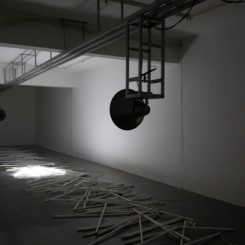Beijing’s exhibitions in 2014 make for an uncertain picture. There is a multitude of spaces, a full calendar of shows and a concentration of artists—this should pose a competitive field. But rather than provoking stronger content, this situation seems largely to have flattened the landscape of exhibitions during the past 12 months, leaving it without much punctuation, and difficult to sum up—this, after a tense period last year, which nonetheless contained some impressive shows (solos by Taryn Simon, Wang Xingwei and Tang Song and the group show “Memo 1” spring to mind). Yet rather than reaching a tipping point for the confidence of artists and galleries, it seems expectations have slowed, and wills perhaps subsided. 2014 had fewer peaks. UCCA continues to work hard, and the new Minsheng Museum (slated to open on the edge of 798 art district in March 2015) might bring more breadth on the museum side, which Beijing dearly needs. Lead mostly by foreigners, a new crop of independent and non-profit outfits has opened in the downtown hutongs (the number of them must be seen as symptomatic); these will be aiming to generate an atmosphere for art in the city which is more grass-roots and community-based, with international links and exchange in the form of diaogues, ’zines and visiting artists (ie., alternatives to art fairs or high-level shows). But while these get going and their organizers gain further experience of running programs, and in the continuing absence of state-sponsored venues supporting contemporary art in the capital, it falls mostly to the commercial galleries in the art districts to lead the scene. At the moment, it appears there is a want of inspiration there, with few striking displays, the persistent issue of depthless abstraction, and slightly underwhelming new work by artists from whom we might have expected more. Meanwhile, the younger generation seem short on ideas—or are simply too rushed (or commercially “encouraged”) to think them through? If ever there was one, this is a moment for a very thoughtful exhibition or body of work to intervene.
There is a maxim to keep in mind. Expectations of artists and the art world in general can be better managed if one remembers that every art piece or idea is an expression on its own. Aside from the scaffolds of intention and context which enable us to see them, each has this independent life which a particular set of conditions, desires and decisions have converged to create. The likelihood that it will speak to you, and given all you bring to seeing it, is very small. This is both the wonder and the difficulty of art works—their attraction and frustration (for artists and viewers alike); each should be particular, and the encounter with them something authentic, in turn. A well-thought out exhibition can be a work of art in itself, but this is a tall order. Better, perhaps, to seek out individual works. Across all the studios, exhibitions and art fairs one might visit in a year, it’s fair to expect a personal reaction to a tiny fraction of it. A cacophony of 250 galleries at a fair might leave one thinking about just two pieces. But these are the reason to keep looking—a memory amid a mass of passing glances. Here are a few recollections from 2014, as seen in Beijing and elsewhere.
Tang Yongxiang, “Blue Background With a Few Profiles” (Tang Yongxiang solo exhibition, Magician Space, Beijing). Tang’s compositions succeed with their embrace of inadequacy, and a surprising and personal kind of abstraction—strange painterly strength.
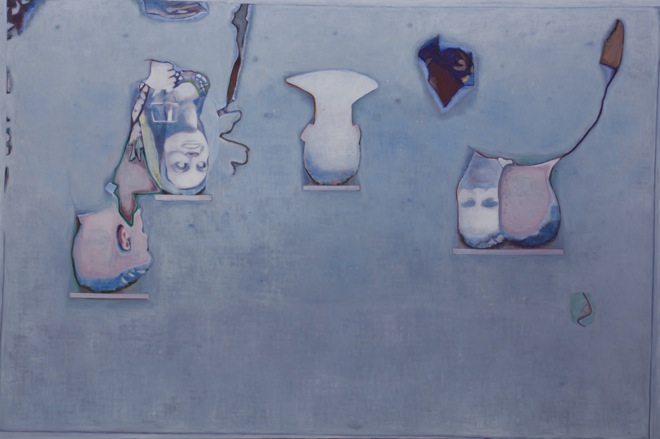
Tang Yongxiang, “Blue Background With a Few Profiles”, oil on Canvas, 200×300cm, 2013
唐永祥,《蓝色背景上有些头像》,布面油画,200×300cm,2013
Ebossyn Meldibekov, Family Album (“Lost to the Future: Contemporary Art from Central Asia”, Lasalle College of the Arts, Singapore). Groups of people photographed in front of monuments, then and later, as time goes on and regimes fall. The series is a memorable collective portrait, documenting history and human lives as they hover in strange relation—each is the others’ backdrop.
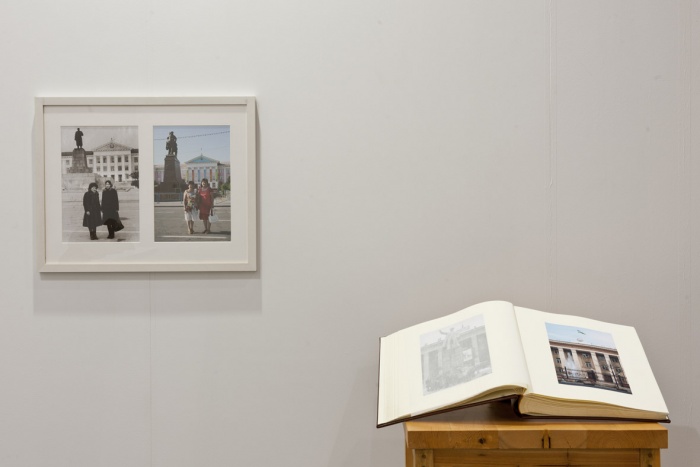
Erbossyn Meldibekov, Family Album, photo album and 10-13 framed photographs, 2007
Song Ta, “The Loveliest Guy” (“The Loveliest Guy”, Beijing Commune, Beijing). The video is a triumph of dead-pan humor.

Song Ta, “Who Is The Loveliest Guy”, video installation, three-channel video, readymade installation, (color photographs, coated paper), video: 3’40’’, photo: 22.7 x 17.4 cm, 2014
宋拓,《谁是最可爱的人》,录像装置、三频录像、现成品装置(彩色相片,铜版纸),视频部分:3‘40“,装置部分:22.7 X 17.4 CM (each),2014
Martin Creed “Mothers” (“What’s the point of it?”, Hayward Gallery, London). This colossal neon sign revolves at just above head-height. Make of the sensation and slogan what you will.
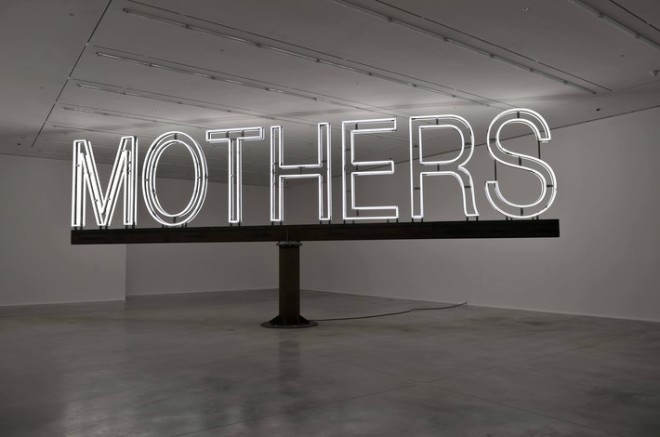
Martin Creed, “Work No. 1092”, white neon, steel, 500 x 1250 x 20 cm, 2011. (Installation at Hauser & Wirth Savile Row, London, © Martin Creed)
Chris Ofili, (“Night and Day”, New Museum, New York). In a very dimly-lit, octagonal room on the third floor of the museum hang a brooding series of large paintings, their midnight black, purple and blue hues barely visible, but definitely present. You try to seek their totalities out, ducking and weaving to find better light—but you can’t. “Night and Day” is a brilliant exhibition overall.
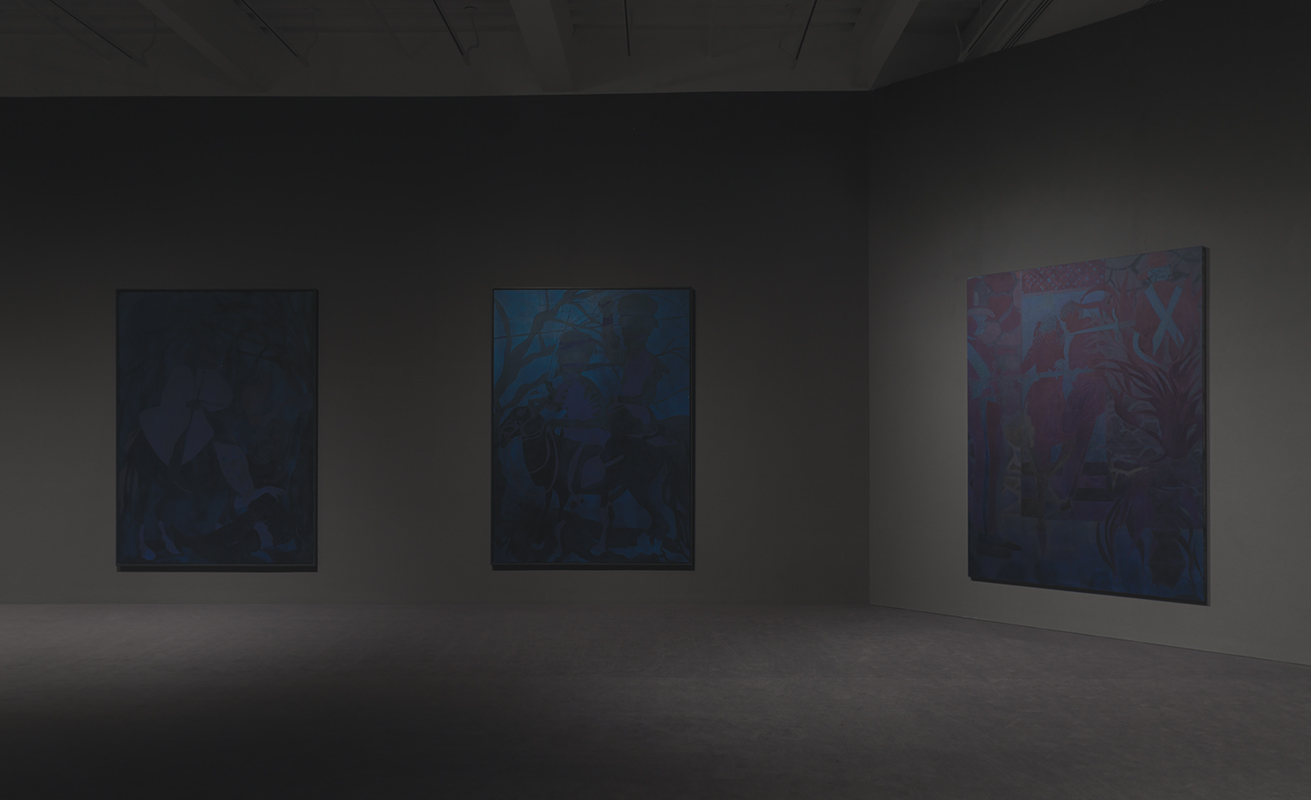
“Chris Ofili: Nightand Day”, third floor installation view at the New Museum. Photo by Maris Hutchinson/EPW. All artworks © Chris Ofili. Courtesy David Zwirner, New York/London.
Zhang Peili “Collision of Harmonies” (“Because…Therefore”, Boers-Li Gallery, Beijing). A real assault of sound and suspense from a self-assured artist unafraid to bore, blind, deafen or frighten you.
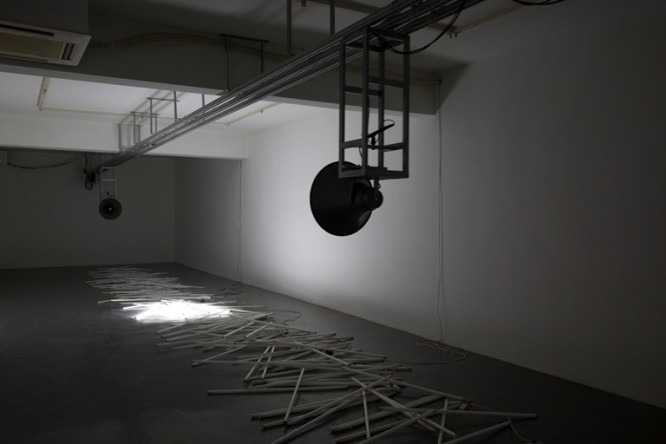
Zhang Peili, “Collision of Harmonies”,sound installation, track, speakers, computer, fluorescent light tubes, 2014
张培力,《碰撞的和声》,声音装置,轨道,喇叭,电脑,日光灯管,2014
Kenneth Armitage, “Anvil Figure” (New Art Centre, UK). From 1961, a hybrid of a strange beast and a heavy object, a surface to strike and a body on awkward legs—somehow beautiful in the final sum.
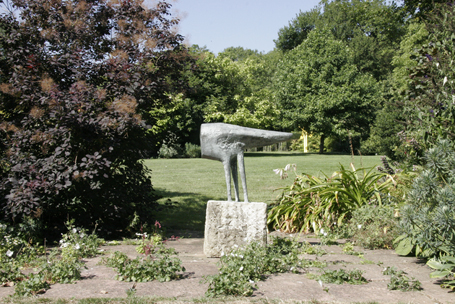
Kenneth Armitage, “Anvil Figure”, bronze, 73 × 82 × 27 cm, 1961
